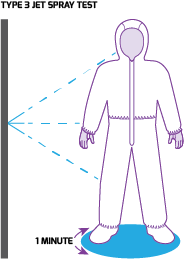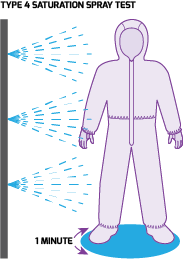Overzicht en beschrijving testen gehele beschermpak
| Type | Standard & Test Method | Test Description | |
|---|---|---|---|
| Type 3 Straal Test |
EN 14605+A1 :2009
|
 |
Deze test bestaat erin om een volledig pak bloot te stellen aan een serie korte stralen van een vloeistof op waterbasis (met een lage oppervlaktespanning van 30-35 m N/m) die gericht wordt op enkele kritieke plekken op het pak. De druk van de straal bij het verlaten van de spuitmond is 3 bar en de spuitmond bevindt zich op een afstand van 1 m van het kledingstuk. De vloeistof is gekleurd zodat er bij lekkage naar de binnenzijde een duidelijke vlek zichtbaar wordt op de onder het pak gedragen kleding. Een pak heeft de test doorstaan als het totale gevlekte oppervlak op de onderkleding kleiner is dan drie keer de controlevlek. (De controlevlek is het gevlekte oppervlak bij applicatie van 0,02 ml testvloeistof.) |
| Type 4 Verzadigende Sproei Test |
EN 14605+A1 :2009
|
 |
Deze test bestaat erin om een volledig pak bloot te stellen aan een intense straal van een vloeistof op waterbasis (met een lage oppervlaktespanning van 30-35 m N/m). Een totale hoeveelheid van 4,5 liter wordt een minuut lang gespoten als een fijne mist. Er wordt door de mist geen druk uitgeoefend op het pak. Terwijl het pak wordt besproeid, voert de drager van het pak kalme bewegingen uit terwijl hij ronddraait. De vloeistof is gekleurd zodat er bij lekkage naar de binnenzijde een duidelijke vlek zichtbaar wordt op de onder het pak gedragen kleding. Een pak heeft de test doorstaan als het totale gevlekte oppervlak op de onderkleding kleiner is dan drie keer de controlevlek. (De controlevlek is het gevlekte oppervlak bij applicatie van 0,02 ml testvloeistof.) |
| Type 5 Deeltjes Inwaartse Lekkage |
EN ISO13982-1:2004+A1:2010
|
De test bestaat in het blootstellen van het hele pak (10 testpakken) aan een droge aerosol van natriumchloride. De grootte van de deeltjes is 0,6 μm. Terwijl het pak wordt blootgesteld, voert de drager van het pak de volgende volgorde van 3 bewegingen uit: 9 minuten staan, 9 minuten lopen, 9 minuten hurken. De totale inwaartse lekkage wordt uitgedrukt als een percentage van de concentratie van de natriumchloride aan de buitenzijde van het pak gemeten voor elk testresultaat op 3 punten – knie, taille en borst. Daarom worden er voor elk pak 9 metingen verricht. Om te voldoen aan de test moet de inwaartse lekkage minder zijn dan 30% voor 82 van de 90 metingen. (Ljmn, 82/90 ≤ 30%). En de gemiddelde inwaartse lekkage (alle bewegingen en metingen posities voor elk pak – 9 aflezingen) moet minder zijn dan 15% voor 8 van de 10 pakken. (Ls, 8/10 ≤ 15%). |
|
|
Type 6 |
EN 13034 :2005+A1 :2009
|
 |
Deze test is essentieel dezelfde als de Type 4 sproeitest maar de vloeistof van de Type 6 test heeft een iets hogere oppervlaktespanning van 57 m N/m en de hoeveelheid die gesproeid wordt is verminderd tot 1,9 liter. Een pak heeft de test doorstaan als het totale gevlekte oppervlak op de onderkleding kleiner is dan drie keer de controlevlek. (De controlevlek is het gevlekte oppervlak bij applicatie van 0,02 ml testvloeistof.) |
| Type | Standard & Test Method | Test Description | |
|---|---|---|---|
| Type 3 Jet Spray Test |
EN 14605+A1 :2009
|
 |
This test involves exposing a whole suit to a series of short jets of a water based liquid (with a low surface tension of 30-35 m N/m) aimed at various critical parts of the suit. The pressure of the jet when leaving the firing nozzle is 3 bar and the firing nozzle is situated at a distance of 1m away from the garment. The liquid is coloured, so that any inward leakage will visibly stain the undergarment. A suit has passed the test when the total stained area on the undergarment is smaller than three times the calibration stain. (The calibration stain is the stain area produced by 0.02 ml of the test liquid.) |
| Type 4 Saturation Spray Test |
EN 14605+A1 :2009
|
 |
This test involves exposing a whole suit to an intense spray of a water based liquid (with a low surface tension of 30-35 m N/m). A total quantity of 4.5 litres is sprayed as a fine mist for one minute. There is no pressure exerted by the fine spray on the suit. While being sprayed, the wearer of the suit will perform gentle movements while rotating. The liquid is coloured, so that any inward leakage will visibly stain the undergarment. A suit has passed the test when the total stained area on the undergarment is smaller than three times the calibration stain. (The calibration stain is the stain area produced by 0.02 ml of the test liquid.) |
| Type 5 Particle Inward Leakage |
EN ISO13982-1:2004+A1:2010
|
This test involves exposing a whole suit (10 test suits) to a dry aerosol of sodium chloride. The particle size is 0.6 μm. While being exposed to the dry aerosol, the wearer of the suit performs the following sequence of 3 movements: 9 minutes standing, 9 minutes walking, 9 minutes squatting. The total inward leakage is expressed as a percentage of the concentration of sodium chloride outside the suit measured for each test suit at 3 points – knee, waist and chest. Therefor, for each suit 9 measurements are taken. In order to pass the test the inward leakage must be less than 30%, for 82 of 90 of the measurements. (Ljmn, 82/90 ≤ 30%). And the average inward leakage (all movements and measurement positions for each suit – 9 readings) must be less than 15% for 8 of the 10 suits. (Ls, 8/10 ≤ 15%). |
|
|
Type 6 |
EN 13034 :2005+A1 :2009
|
 |
This test is essentially the same as the Type 4 spray test however the liquid in the Type 6 test has a slightly higher surface tension of 57 m N/m and the quantity sprayed is reduced to 1.9 litres. A suit passes the test when the total stained area on the undergarment is smaller than three times the calibration stain. (The calibration stain is the stain area produced by 0.02 ml of the test liquid.) |

